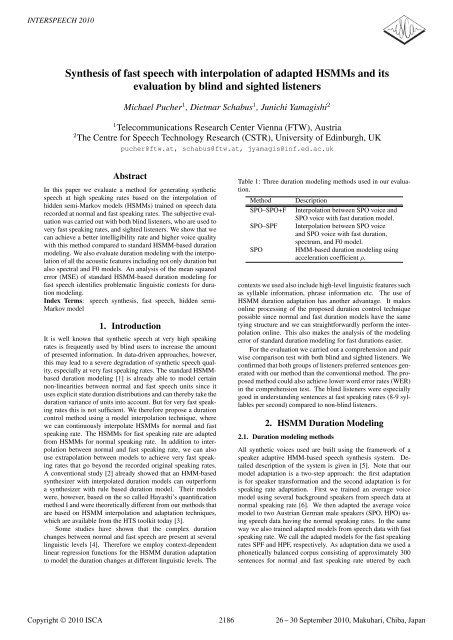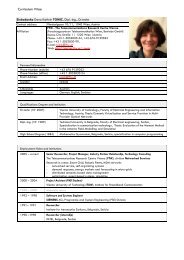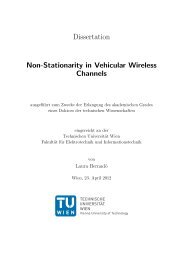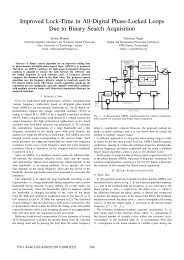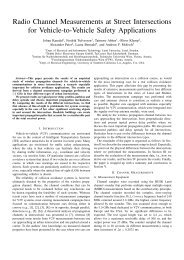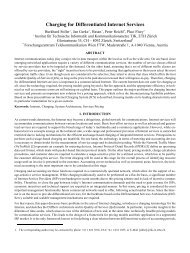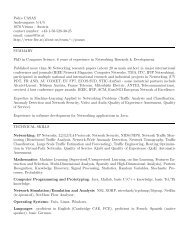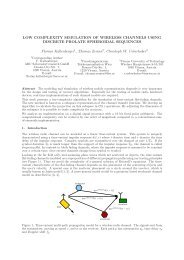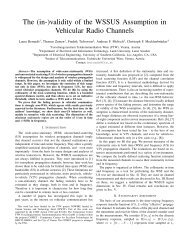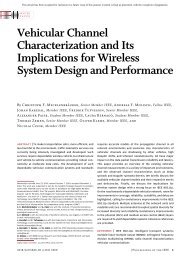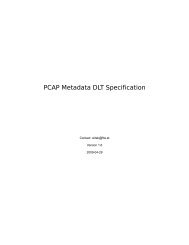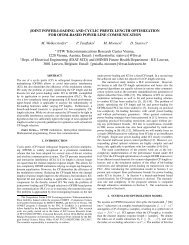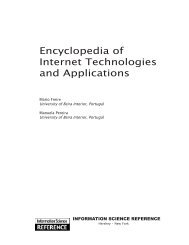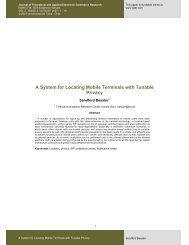Synthesis of Fast Speech with Interpolation of Adapted HSMMs and ...
Synthesis of Fast Speech with Interpolation of Adapted HSMMs and ...
Synthesis of Fast Speech with Interpolation of Adapted HSMMs and ...
Create successful ePaper yourself
Turn your PDF publications into a flip-book with our unique Google optimized e-Paper software.
INTERSPEECH 2010<br />
<strong>Synthesis</strong> <strong>of</strong> fast speech <strong>with</strong> interpolation <strong>of</strong> adapted <strong>HSMMs</strong> <strong>and</strong> its<br />
evaluation by blind <strong>and</strong> sighted listeners<br />
Michael Pucher 1 , Dietmar Schabus 1 , Junichi Yamagishi 2<br />
1 Telecommunications Research Center Vienna (FTW), Austria<br />
2 The Centre for <strong>Speech</strong> Technology Research (CSTR), University <strong>of</strong> Edinburgh, UK<br />
pucher@ftw.at, schabus@ftw.at, jyamagis@inf.ed.ac.uk<br />
Abstract<br />
In this paper we evaluate a method for generating synthetic<br />
speech at high speaking rates based on the interpolation <strong>of</strong><br />
hidden semi-Markov models (<strong>HSMMs</strong>) trained on speech data<br />
recorded at normal <strong>and</strong> fast speaking rates. The subjective evaluation<br />
was carried out <strong>with</strong> both blind listeners, who are used to<br />
very fast speaking rates, <strong>and</strong> sighted listeners. We show that we<br />
can achieve a better intelligibility rate <strong>and</strong> higher voice quality<br />
<strong>with</strong> this method compared to st<strong>and</strong>ard HSMM-based duration<br />
modeling. We also evaluate duration modeling <strong>with</strong> the interpolation<br />
<strong>of</strong> all the acoustic features including not only duration but<br />
also spectral <strong>and</strong> F0 models. An analysis <strong>of</strong> the mean squared<br />
error (MSE) <strong>of</strong> st<strong>and</strong>ard HSMM-based duration modeling for<br />
fast speech identifies problematic linguistic contexts for duration<br />
modeling.<br />
Index Terms: speech synthesis, fast speech, hidden semi-<br />
Markov model<br />
1. Introduction<br />
It is well known that synthetic speech at very high speaking<br />
rates is frequently used by blind users to increase the amount<br />
<strong>of</strong> presented information. In data-driven approaches, however,<br />
this may lead to a severe degradation <strong>of</strong> synthetic speech quality,<br />
especially at very fast speaking rates. The st<strong>and</strong>ard HSMMbased<br />
duration modeling [1] is already able to model certain<br />
non-linearities between normal <strong>and</strong> fast speech units since it<br />
uses explicit state duration distributions <strong>and</strong> can thereby take the<br />
duration variance <strong>of</strong> units into account. But for very fast speaking<br />
rates this is not sufficient. We therefore propose a duration<br />
control method using a model interpolation technique, where<br />
we can continuously interpolate <strong>HSMMs</strong> for normal <strong>and</strong> fast<br />
speaking rate. The <strong>HSMMs</strong> for fast speaking rate are adapted<br />
from <strong>HSMMs</strong> for normal speaking rate. In addition to interpolation<br />
between normal <strong>and</strong> fast speaking rate, we can also<br />
use extrapolation between models to achieve very fast speaking<br />
rates that go beyond the recorded original speaking rates.<br />
A conventional study [2] already showed that an HMM-based<br />
synthesizer <strong>with</strong> interpolated duration models can outperform<br />
a synthesizer <strong>with</strong> rule based duration model. Their models<br />
were, however, based on the so called Hayashi’s quantification<br />
method I <strong>and</strong> were theoretically different from our methods that<br />
are based on HSMM interpolation <strong>and</strong> adaptation techniques,<br />
which are available from the HTS toolkit today [3].<br />
Some studies have shown that the complex duration<br />
changes between normal <strong>and</strong> fast speech are present at several<br />
linguistic levels [4]. Therefore we employ context-dependent<br />
linear regression functions for the HSMM duration adaptation<br />
to model the duration changes at different linguistic levels. The<br />
Table 1: Three duration modeling methods used in our evaluation.<br />
Method Description<br />
SPO–SPO+F <strong>Interpolation</strong> between SPO voice <strong>and</strong><br />
SPO voice <strong>with</strong> fast duration model.<br />
SPO–SPF <strong>Interpolation</strong> between SPO voice<br />
<strong>and</strong> SPO voice <strong>with</strong> fast duration,<br />
spectrum, <strong>and</strong> F0 model.<br />
SPO HMM-based duration modeling using<br />
acceleration coefficient ρ.<br />
contexts we used also include high-level linguistic features such<br />
as syllable information, phrase information etc. The use <strong>of</strong><br />
HSMM duration adaptation has another advantage. It makes<br />
online processing <strong>of</strong> the proposed duration control technique<br />
possible since normal <strong>and</strong> fast duration models have the same<br />
tying structure <strong>and</strong> we can straightforwardly perform the interpolation<br />
online. This also makes the analysis <strong>of</strong> the modeling<br />
error <strong>of</strong> st<strong>and</strong>ard duration modeling for fast durations easier.<br />
For the evaluation we carried out a comprehension <strong>and</strong> pair<br />
wise comparison test <strong>with</strong> both blind <strong>and</strong> sighted listeners. We<br />
confirmed that both groups <strong>of</strong> listeners preferred sentences generated<br />
<strong>with</strong> our method than the conventional method. The proposed<br />
method could also achieve lower word error rates (WER)<br />
in the comprehension test. The blind listeners were especially<br />
good in underst<strong>and</strong>ing sentences at fast speaking rates (8-9 syllables<br />
per second) compared to non-blind listeners.<br />
2. HSMM Duration Modeling<br />
2.1. Duration modeling methods<br />
All synthetic voices used are built using the framework <strong>of</strong> a<br />
speaker adaptive HMM-based speech synthesis system. Detailed<br />
description <strong>of</strong> the system is given in [5]. Note that our<br />
model adaptation is a two-step approach: the first adaptation<br />
is for speaker transformation <strong>and</strong> the second adaptation is for<br />
speaking rate adaptation. First we trained an average voice<br />
model using several background speakers from speech data at<br />
normal speaking rate [6]. We then adapted the average voice<br />
model to two Austrian German male speakers (SPO, HPO) using<br />
speech data having the normal speaking rates. In the same<br />
way we also trained adapted models from speech data <strong>with</strong> fast<br />
speaking rate. We call the adapted models for the fast speaking<br />
rates SPF <strong>and</strong> HPF, respectively. As adaptation data we used a<br />
phonetically balanced corpus consisting <strong>of</strong> approximately 300<br />
sentences for normal <strong>and</strong> fast speaking rate uttered by each<br />
Copyright © 2010 ISCA 2186<br />
26-30 September 2010, Makuhari, Chiba, Japan
p1(1)<br />
1<br />
p1(2)<br />
1<br />
p1(3)<br />
1<br />
p1(4)<br />
1<br />
p1(5)<br />
1<br />
pi(d)<br />
p2(1)<br />
2<br />
p2(2)<br />
2<br />
p2(3)<br />
2<br />
p2(4)<br />
2<br />
p2(5)<br />
2<br />
: Duration Probability<br />
p3(1)<br />
3<br />
p3(2)<br />
3<br />
p3(3)<br />
3<br />
p3(4)<br />
3<br />
p3(5)<br />
3<br />
Figure 1: WFST-like illustration <strong>of</strong> duration models used for<br />
TTS systems. Duration probabilities pi are also transformed to<br />
target speakers during speaker adaptation.<br />
speaker. Table 1 shows the three methods that were used in<br />
the evaluation. SPO–SPO+F <strong>and</strong> SPO–SPF are the proposed<br />
methods that use interpolations <strong>of</strong> adapted <strong>HSMMs</strong>.<br />
To make the differences between the three methods clearer,<br />
we explain the temporal structure <strong>of</strong> the <strong>HSMMs</strong> [7] <strong>and</strong><br />
its adaptation. In addition to observations such as the melcepstrum<br />
<strong>and</strong> fundamental frequency, each semi-Markov state<br />
has a stack <strong>of</strong> states <strong>with</strong> associated duration probabilities pi,<br />
illustrated in Figure 1. The duration probabilities pi are characterized<br />
by Gaussian pdfs, <strong>and</strong> the mean <strong>and</strong> variance <strong>of</strong> the<br />
pdfs<br />
pi(d) =N (d; μi,σ 2 i ). (1)<br />
In the HSMM-based parameter generation [1], we use the mean<br />
sequence (μ1, ··· ,μN ) <strong>of</strong> the Gaussian pdfs corresponding to a<br />
given input unit sequence as the most likely sequence. Here N<br />
represents the number <strong>of</strong> states. The easiest <strong>and</strong> simplest way<br />
to control duration is to manipulate the mean <strong>of</strong> each state using<br />
the variance <strong>of</strong> the state<br />
ˆμi = μi + ρσ 2 i<br />
<strong>and</strong> to use a sequence (ˆμ1, ··· , ˆμN ) as a state sequence for the<br />
parameter generation. Here ρ is an acceleration coefficient <strong>and</strong><br />
ρ>0 makes synthetic speech slower <strong>and</strong> ρ
Figure 3: Top <strong>of</strong> the duration clustering tree. Nodes filled in a<br />
darker shade <strong>of</strong> red have greater average error defined by Equation<br />
9.<br />
<strong>of</strong> all leaves under n:<br />
ēn =<br />
<br />
k∈leaves(n) ek<br />
. (9)<br />
|leaves(n)|<br />
Figure 3 shows the top <strong>of</strong> the duration clustering tree <strong>with</strong><br />
the nodes colored according to their error (Equation 9) for<br />
speaker SPO. Looking at the entire tree (which has 1897 leaves<br />
<strong>and</strong> hence 1896 inner nodes) reveals that the subtree rooted at<br />
the node labeled “R-Vowel” (“right phoneme is a vowel”) has<br />
particularly many problematic models. Each node in the figure<br />
is labeled <strong>with</strong> the corresponding question as well as the ratio<br />
<strong>of</strong> the errors <strong>of</strong> its children, ei→no : ei→yes. For example, the<br />
root node question “C-Vowel” asks whether the central phone<br />
is a vowel. We see that the average error for non-vowels is<br />
135 times as big as for vowels. Among the non-vowels, phones<br />
which belong to the class “C-Neither F or L” (“central phone<br />
is neither fortis nor lenis”) are particularly error-prone, <strong>and</strong> <strong>of</strong><br />
these, current unvoiced consonants (“C-Unvoiced Consonant”)<br />
are not quite as bad.<br />
During the construction <strong>of</strong> the tree, the class “C-<br />
Neither F or L” was defined as containing the phones /l/, /m/,<br />
/n/, /N/ <strong>and</strong> /h/. Of these, only /h/ belongs to the unvoiced<br />
consonants, hence the central phone for all models under the<br />
node labeled “R-vowel” must be one <strong>of</strong> /l/, /m/, /n/, /N/. We<br />
can see how bad this subtree really is by looking at the cumulative<br />
error made by all its leaves (<strong>with</strong>out averaging): The subtree<br />
rooted at “R-Vowel” accounts for more than 98% <strong>of</strong> the<br />
total error in the whole tree, but it only accounts for about 13%<br />
<strong>of</strong> the number <strong>of</strong> leaves.<br />
For speaker HPO, we do not see such clearly distinguished<br />
subtrees, however the general trend <strong>of</strong> consonants having<br />
greater average error is confirmed also here. This could be<br />
due to more inconsistency <strong>of</strong> speaker HPO in terms <strong>of</strong> duration.<br />
3. Evaluation<br />
We evaluated two different male speaker’s voices namely SPO<br />
<strong>and</strong> HPO. The duration modeling methods for one voice are<br />
described in Table 1. We generated utterances <strong>with</strong> 7 different<br />
durations using the st<strong>and</strong>ard HSMM-based synthesis duration<br />
method (SPO), interpolation between normal <strong>and</strong> fast duration<br />
model (SPO–SPO+F), <strong>and</strong> interpolation between normal<br />
<strong>and</strong> fast duration, spectrum, <strong>and</strong> F0 model (SPO–SPF). In the<br />
2188<br />
Syllables per second<br />
10<br />
9<br />
8<br />
7<br />
6<br />
5<br />
4<br />
3<br />
0.0 0.4 0.8 1.0<br />
<strong>Interpolation</strong> ratio<br />
1.2 1.3 1.4<br />
Figure 4: Syllables per second for SPO sentences.<br />
Table 2: Overall word-error rate (WER) <strong>and</strong> sentence-error-rate<br />
(SER) for blind <strong>and</strong> sighted listeners.<br />
Listeners WER / SER in % # sent.<br />
Blind listeners 19.5 / 57.4 108<br />
Sighted listeners 24.4 / 70.4 216<br />
pair wise comparison we compare the same utterance <strong>with</strong> the<br />
same duration <strong>and</strong> speaker using different modeling methods.<br />
For the evaluation we had 18 sighted listeners (24 to 55<br />
years; 9 female / 9 male) <strong>and</strong> 9 blind listeners (28 to 56 years;<br />
4 female / 5 male). Within the group <strong>of</strong> blind listeners we had<br />
2 visually impaired listeners. The users first had to listen once<br />
to 12 sentences <strong>and</strong> write down what they have heard (comprehension<br />
test). Afterwards they had to listen to pairs <strong>of</strong> sentences<br />
<strong>and</strong> decide which sentence they prefer in terms <strong>of</strong> overall quality.<br />
In the pair wise comparison each pair was listened to at least<br />
two times by some user.<br />
3.1. Duration <strong>of</strong> prompts<br />
The duration <strong>of</strong> prompts is determined by the interpolation<br />
ratio <strong>and</strong> therefore depends on the speaker’s duration<br />
model. As interpolation ratio we used the following values<br />
[0.0, 0.4, 0.8, 1.0, 1.2, 1.3, 1.4]. With 0.0 <strong>and</strong> 1.0 no interpolation<br />
is done <strong>and</strong> only the normal or fast duration model is<br />
used. [1.2, 1.3, 1.4] are extrapolation ratios to achieve very fast<br />
speaking rates. For the evaluation we had 12 different prompts.<br />
Figure 4 shows how many syllables per second are realized for<br />
the different sentences by speaker SPO. The fastest sentences<br />
contain up to 9 syllables per second.<br />
3.2. Comprehension<br />
Table 2 shows the error rates for blind <strong>and</strong> sighted listeners.<br />
Blind listeners are better in underst<strong>and</strong>ing fast speech than<br />
sighted listeners. This can also be seen from Figure 5 where<br />
we plotted the word-error-rates for the different interpolation ratios.<br />
One can see that blind listeners are especially good at recognizing<br />
fast speech [1.3, 1.4] where the error rate for sighted<br />
listeners is much higher. While the WERs for sighted listeners<br />
are almost monotonically increasing, WERs for blind listeners<br />
are flat from 1.2 to 1.4. Table 3 shows that in general we can<br />
also achieve lower WERs using our interpolation method SPO–<br />
SPO+F compared to the st<strong>and</strong>ard method.
Table 3: Word-error rate (WER) <strong>and</strong> sentence-error-rate (SER)<br />
per method.<br />
Method WER / SER in % # sent.<br />
SPO–SPO+F 16.4 / 61.1 54<br />
SPO–SPF 21.1 / 66.7 54<br />
SPO 23.2 / 66.7 54<br />
HPO–HPO+F 24.3 / 66.7 54<br />
HPO–HPF 25.3 / 63.0 54<br />
HPO 26.3 / 72.2 54<br />
Word−error−rate (WER) in %<br />
45<br />
40<br />
35<br />
30<br />
25<br />
20<br />
15<br />
10<br />
WER for blind listeners<br />
WER for sighted listeners<br />
5<br />
0.0 0.4 0.8 1.0<br />
<strong>Interpolation</strong> ratio<br />
1.2 1.3 1.4<br />
Figure 5: Word-error-rate for blind <strong>and</strong> sighted listeners per interpolation<br />
ratio.<br />
Other work [9] has shown that the error rate for non-blind<br />
listeners increases fast from a rate <strong>of</strong> 10.5 syllables per seconds<br />
onwards. In that study, comprehension was subjectively measured<br />
by asking listeners how much they could underst<strong>and</strong> <strong>of</strong><br />
the text. As shown by Figure 4 <strong>and</strong> 5, the division between blind<br />
<strong>and</strong> sighted listeners concerning underst<strong>and</strong>ing can already be<br />
seen at around 8 syllables per second when using the objective<br />
word error rate measure.<br />
3.3. Pair wise comparison<br />
Figure 6 shows the preference rates for the different methods<br />
for all listeners. We see that the adaptive interpolation method<br />
where just the duration model is interpolated outperforms the<br />
other methods. SPO–SPO+F <strong>and</strong> HPO–HPO+F are significantly<br />
different from the other two methods (p


